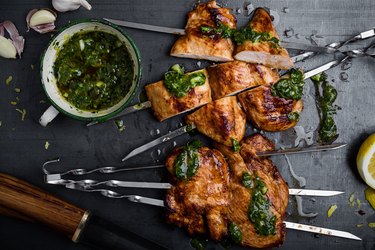
Cooking the perfect morsel of chicken at home doesn't require a culinary degree. You just need to know when to bake chicken covered or uncovered, to create the flavors and textures to complete your meal.
Tip
Always cover a chicken stew to use the steam to help tenderize the bird. Baked chicken breasts may benefit from a light cover to keep them moist. If want crispy skin, however, don’t cover your chicken.
Video of the Day
How you cook your chicken determines whether or not it requires a lid, or a tent of foil or parchment. Tender, braised dishes benefit from a lid that keeps in the steam, but when you want a roast chicken with crisp skin, leave the covering off.
Video of the Day
Stewed Chicken Dishes
Whether you bake chicken covered or uncovered depends on your end goal. If you're making a stew, such as a chili or Cacciatore, you do want to cover the dish. A proper stew calls for you to cover the chicken with enough liquid (such as stock or water) to come up almost to the same level as the parts, but not cover them.
You'll bring the liquid to a boil with the lid placed firmly on the pot, then reduce the heat so the stew can simmer. At this point, move the lid to the side so it's just partially covering the stew. This helps keep the steam in, but also allows the liquid to reduce and thicken slightly, to make a delicious sauce.
Stewed chicken that includes both the meat and skin contains 242 calories per 3-ounce serving. It also offers 22 grams of protein, and 16 grams of fat.
Roasted Chicken Meals
A roasted chicken is a classic dish containing 190 calories per 3-ounce portion. You also get 20 grams of protein and 11 grams of fat.
The procedure for roasting a chicken is relatively simple. Cover it generously with salt, spices and black pepper. Some recipes also call for a generous slathering of butter. When you coat the chicken, don't forget the hidden spots, such as underneath the wings, between the thighs, and along the back. You want these areas to be flavorful, and for the skin to crisp up.
Set the chicken in a high-heat oven — usually 425 to 450 degrees Fahrenheit. Cook the bird just until the skin starts to brown and crisp, and then reduce the heat to 350 to 400 degrees, until the chicken cooks through. If the pointy tips of the wings start to get too dark, it's appropriate to cap them with bits of foil to prevent burning.
Tender Chicken Breast
When you're cooking just the breast, the decision about whether to bake chicken covered or uncovered depends on your desired outcome. If the breast is breaded, or the skin is still intact, you should not cover it. This ensures a crispy coating or skin.
Boneless, skinless chicken breast cuts tend to dry out when baked. To achieve a tender chicken breast, cover the uncooked meat with a tent of foil or parchment before placing it in the oven. For full flavor, you'll sprinkle salt, pepper and dried oregano onto the breast, and cook it alongside a few wedges of lemon.
Chicken breasts are a good source of lean protein, offering just 140-calories per 3-ounce portion (with the skin removed.) This serving contains 26 grams of protein and 3 grams of fat, too. Leaving the skin on increases the calorie count by 25 to 30 percent, explains a paper published in Food and Nutrition Research in June, 2015.
- Bon Appetit: "How to Roast a Chicken"
- Christian Science Monitor: "Stewed Chicken"
- Epicurious: "Baked Chicken Breasts"
- Food and Nutrition Research: "Role of Poultry Meat in a Balanced Diet Aimed at Maintaining Health and Wellbeing: An Italian Consensus Document"
- "Fine Cooking"; Roast Chicken Made Better, Start to Finish; Beth Dooley, et al.